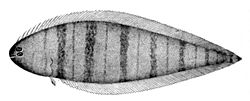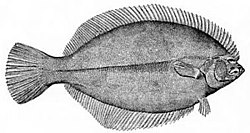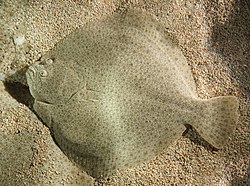| Tonguefish | |
|---|---|
 | |
| Northern tonguefish, Symphurus pusillus | |
| Scientific classification | |
| Kingdom: | Animalia |
| Phylum: | Chordata |
| Class: | Actinopterygii |
| Order: | Carangiformes |
| Suborder: | Pleuronectoidei |
| Family: | Cynoglossidae Jordan, 1888 |
| Subfamilies and genera [1] | |
Subfamily Cynoglossinae Subfamily Symphurinae | |

Tonguefishes are flatfish in the family Cynoglossidae. They are distinguished by the presence of a long hook on the snout overhanging the mouth, and the absence of pectoral fins. Their eyes are both on the left side of their bodies, which also lack a pelvic fin. [2] This family has three genera with a total of more than 140 species. The largest reaches a length of 66 cm (26 in), though most species only reach half that size or less. [3] [4] [5] They are found in tropical and subtropical oceans, mainly in shallow waters and estuaries, though some species are found in deep sea floors, [6] and even a few in rivers.
Symphurus thermophilus lives congregating around "ponds" of sulphur at hydrothermal vents on the seafloor. No other flatfish is known from hydrothermal vents. [7] Scientists are unsure of the mechanism that allows the fish to survive and even thrive in such a hostile environment. [8]



